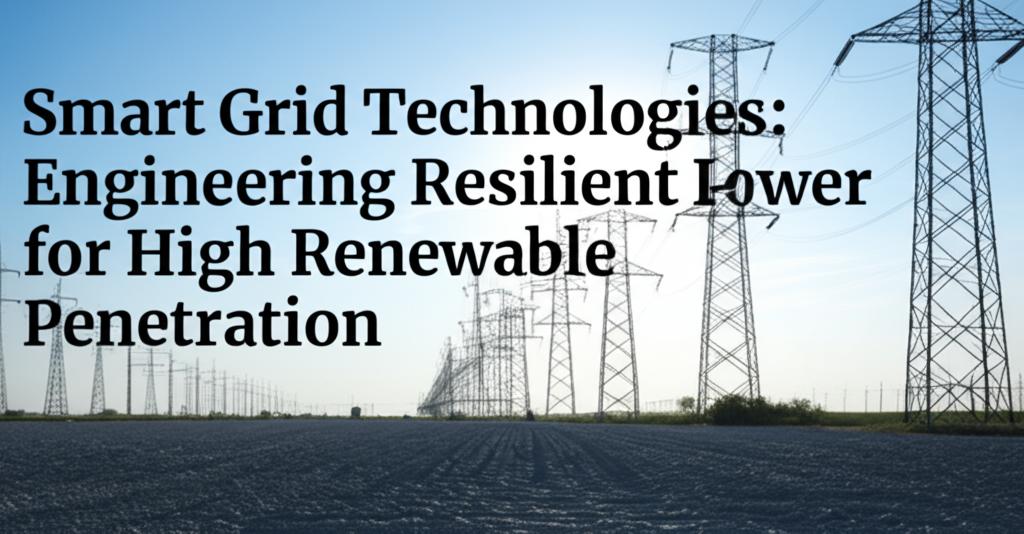The transition towards a clean energy future hinges on integrating vast amounts of renewable energy sources like solar and wind power into our electricity grids. However, these sources are inherently variable and intermittent, posing significant challenges to the stability and reliability of traditional power systems designed for consistent, centralized generation. Smart grid technologies offer the essential tools and strategies to engineer resilient power systems capable of handling high renewable penetration while ensuring a dependable energy supply.
The Challenge of Integrating High Levels of RenewablesTraditional power grids face several hurdles when incorporating large shares of variable renewable energy:
- Intermittency and Variability: Solar output fluctuates with cloud cover and time of day, while wind power depends on weather patterns. This variability makes balancing electricity supply and demand in real-time more complex.
- Grid Stability: Rapid changes in renewable generation can affect grid frequency and voltage, potentially leading to instability if not managed properly. The reduction of system inertia from conventional generators being replaced by inverter-based resources (like solar and wind) further challenges stability.
- Infrastructure Limitations: Existing transmission and distribution networks were often not built to handle bidirectional power flows (from distributed sources like rooftop solar) or the large power transfers required from remote renewable energy zones. This can lead to congestion and the need for costly upgrades.
- Predictability: Forecasting renewable energy output accurately is crucial for grid operations but remains a challenge due to weather uncertainties.
Smart grids leverage digital communication technology, automation, and advanced analytics to create a more flexible, efficient, and reliable power system. Key technologies enabling resilience with high renewables include:
- Advanced Metering Infrastructure (AMI): Smart meters provide real-time data on energy consumption and grid conditions, enabling two-way communication between utilities and consumers. This data is foundational for demand response programs and better grid management.
- Distributed Energy Resource Management Systems (DERMS): As resources like rooftop solar, batteries, electric vehicles (EVs), and smart appliances (collectively known as Distributed Energy Resources or DERs) proliferate, DERMS platforms are crucial. They monitor, manage, and aggregate these DERs, allowing utilities to leverage their flexibility for grid support, balancing supply and demand locally, and improving reliability.
- Microgrids: These are localized sections of the grid—serving a campus, industrial park, or community—that can operate autonomously (islanded) from the main grid during outages. Microgrids often incorporate local renewables and energy storage, significantly enhancing resilience for critical facilities and communities by providing backup power.
- Advanced Energy Storage Systems (ESS): Battery storage, deployed at utility-scale or distributed levels (behind-the-meter), is critical. ESS can absorb excess renewable generation when supply exceeds demand and discharge it later when needed, smoothing out variability, providing backup power, and offering grid services like frequency regulation. Other storage technologies like flow batteries and thermal storage are also emerging.
- Artificial Intelligence (AI) and Machine Learning (ML): AI algorithms are revolutionizing grid operations. They enhance forecasting accuracy for both renewable generation and load demand, enable predictive maintenance to prevent equipment failures, optimize power flow, and automate complex control decisions in real-time, improving both efficiency and resilience.
- Advanced Grid Monitoring and Control: Technologies like sensors (thermal, visual), Supervisory Control and Data Acquisition (SCADA) systems, Advanced Distribution Management Systems (ADMS), and Dynamic Line Rating (DLR) provide greater visibility into grid conditions. This allows operators to manage power flows more effectively, detect and isolate faults faster (enabling self-healing capabilities), and maximize the use of existing infrastructure.
- Demand Response (DR) and Flexibility Services: Smart grids facilitate DR programs that incentivize consumers to adjust their electricity usage during peak times or when renewable generation is low. This flexibility, often automated through smart devices, helps balance the grid, reduces the need for expensive peaking power plants, and integrates renewables more efficiently. EV smart charging and Vehicle-to-Grid (V2G) technologies add further flexibility potential.
- Grid-Enhancing Technologies (GETs): These include solutions like advanced conductors that increase transmission line capacity, advanced power flow control devices, and High-Voltage Direct Current (HVDC) transmission systems, which are highly efficient for moving large amounts of renewable power over long distances with lower losses and better control.
By integrating these smart grid technologies, power systems can overcome the challenges posed by high renewable penetration. They move beyond the limitations of the traditional grid towards a system that is more:
- Resilient: Better equipped to anticipate, withstand, and rapidly recover from disruptions, whether from extreme weather events or grid instability caused by fluctuating renewables.
- Flexible: Capable of dynamically balancing variable generation and demand through storage, demand response, and intelligent control.
- Efficient: Optimizing power flows, reducing energy losses, and maximizing the utilization of both existing infrastructure and renewable resources.
- Sustainable: Enabling the large-scale integration of clean energy sources, reducing reliance on fossil fuels, and lowering carbon emissions.
While challenges remain, including the need for significant investment, supportive regulatory frameworks, robust cybersecurity measures, and standardization, the deployment of smart grid technologies is indispensable. They are the engineering foundation upon which resilient, reliable, and sustainable power systems, powered predominantly by renewable energy, will be built.

